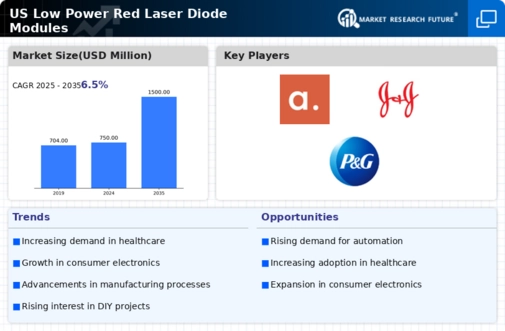Expansion in Industrial Applications
The low power-red-laser-diode-modules market is poised for growth as industrial applications expand. Industries such as manufacturing, logistics, and retail are increasingly integrating laser technology for automation and efficiency. For instance, laser diodes are utilized in precision cutting, marking, and scanning processes. The industrial automation market is expected to grow at a CAGR of around 9% from 2025 to 2030, which could drive demand for low power-red-laser-diode-modules. This expansion suggests that as industries seek to enhance productivity and reduce operational costs, the adoption of laser technology will likely increase, thereby benefiting the low power-red-laser-diode-modules market.
Growing Adoption in Consumer Electronics
The low power-red-laser-diode-modules market is experiencing a notable increase in demand due to the growing adoption of laser technology in consumer electronics. Devices such as laser pointers, barcode scanners, and optical disc drives are increasingly utilizing these modules. The market for consumer electronics is projected to reach approximately $400 billion by 2026, with laser technology playing a crucial role in enhancing product functionality. This trend indicates a shift towards more sophisticated devices that require efficient and compact laser solutions. As manufacturers seek to improve user experience and device performance, the low power-red-laser-diode-modules market is likely to benefit significantly from this consumer electronics boom.
Increased Focus on Safety and Compliance
The low power-red-laser-diode-modules market is influenced by an increased focus on safety and compliance standards across various industries. Regulatory bodies are establishing stringent guidelines for laser safety, which is prompting manufacturers to adopt safer technologies. This shift is particularly evident in sectors such as healthcare and manufacturing, where compliance with safety standards is paramount. As companies invest in safer laser solutions, the demand for low power-red-laser-diode-modules that meet these standards is expected to rise. This trend not only enhances user safety but also drives innovation within the low power-red-laser-diode-modules market.
Emerging Applications in Telecommunications
The low power-red-laser-diode-modules market is likely to benefit from emerging applications in telecommunications. As the demand for high-speed data transmission increases, laser diodes are being explored for their potential in fiber optic communication systems. The telecommunications industry is projected to grow significantly, with investments in infrastructure and technology upgrades. This growth could lead to a heightened demand for low power-red-laser-diode-modules, as they offer efficient solutions for data transmission. The integration of laser technology in telecommunications suggests a promising future for the low power-red-laser-diode-modules market, as it aligns with the industry's push for faster and more reliable communication.
Rising Interest in DIY and Hobbyist Projects
The low power-red-laser-diode-modules market is witnessing a surge in interest from DIY enthusiasts and hobbyists. The accessibility of laser technology has empowered individuals to engage in projects ranging from home automation to custom engraving. Online platforms and communities are proliferating, providing resources and support for DIY projects that utilize low power-red-laser-diode-modules. This trend is indicative of a broader movement towards personalization and customization in consumer products. As more individuals explore creative applications for laser technology, the market is likely to see increased sales and innovation, further solidifying its position in the DIY sector.













Leave a Comment